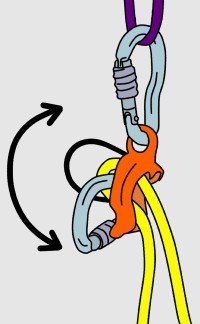Belaying in guide mode is a valuable skill for multi-pitch climbing, allowing the leader to safely bring up the second climber. This technique is particularly useful when climbing as a team of three or on easier routes where lowering the climber is unlikely. This guide focuses on how to effectively and safely top belay using an ATC Guide device. Important: Never use guide mode for lead belaying.
Setting Up Your ATC Guide for Top Belaying
Certain ATC-style belay devices come equipped with a ‘guide mode’ function, enabling them to lock automatically if the climber falls. These devices can also be used for standard belaying. Setting up guide mode can be done with a single rope or two ropes.
To use guide mode, simply pull the brake strands through the device as the climber ascends. In the event of a fall, the device will lock almost instantly. Although guide mode belay devices are auto-locking, it is crucial to always maintain a firm grip on the brake rope.
Advantages of Using Guide Mode:
- Increased Comfort: The weight of a falling climber is borne by the anchor, rather than your harness.
- Belaying Two Climbers: You can bring up two climbers simultaneously on separate ropes, ideal for a team of three.
- Easy Detachment: You are not directly tethered to the belay device, simplifying detachment from the system in emergencies.
Disadvantage:
- Difficult Lowering: Lowering a climber, even a short distance, can be time-consuming and require additional steps.
Ideal Scenarios for Guide Mode:
- Easy Slab Routes: When lowering the climber is improbable.
- Teams of Three: When climbing with three people.
Lowering a Climber in Guide Mode: A Step-by-Step Approach
Before utilizing guide mode, it is essential to fully understand how to lower a climber.
Note: The belayer’s anchor attachment is omitted from the diagrams below for clarity.
Short-Distance Lowering
For small adjustments, you can wiggle the belay carabiner while the climber weights the rope. Carabiners with a round cross-section may not be as effective for this technique.
Long-Distance Lowering
Several methods exist for lowering a climber a longer distance, with varying degrees of speed and safety. The following method prioritizes safety.
Step 1: Redirect the brake strand(s) through a high point on the anchor using a screwgate carabiner. Then, attach a prusik knot around the rope and clip it to your belay loop.
Step 2: Girth hitch a sling through the small hole on your belay device. (Newer devices feature a larger hole suitable for a carabiner; if yours does, clip a sling to it with a carabiner).
Step 3: Redirect the sling through a high point on the anchor with a carabiner, then connect the sling to your belay loop with another carabiner. This enables you to use your body weight to release the belay device.
Alternatively, you can stand in the sling to release the belay device, though clipping it to your harness often offers more control.
You are now prepared to lower the climber in a controlled manner. Remember to slide the prusik knot downwards as you lower.
Warning: Never weight the belay carabiner as shown below. This action will disengage the device, potentially causing the climber to fall.
Tying-Off a Climber While Top Belaying with ATC Guide
If you require complete hands-free operation while belaying in guide mode, you can tie off the device.
Simply create a loop in the brake strand and clip it to the rope. Note that if the knot becomes jammed against the belay device, lowering the climber will be difficult without first belaying them upwards a few inches. Consider this before tying them off.
Top Tip: When switching leads on a multi-pitch climb, you’ll need to transition from Guide Mode to normal belaying once the second has reached the anchor. To achieve this, belay the second using a separate belay device in the standard manner, then disassemble the Guide Mode setup. Ideally, the next leader should remove the Guide Mode setup, allowing the belayer to maintain full focus on belaying.
Guide Mode with a GriGri: An Alternative Approach
While this article primarily focuses on ATC-style devices, it’s worth noting that you can belay directly from the anchor with an assisted-braking belay device like a GriGri in a manner similar to the guide mode technique.
However, this method can be extremely dangerous if executed improperly. Proceed with caution and seek expert instruction before attempting this method.

